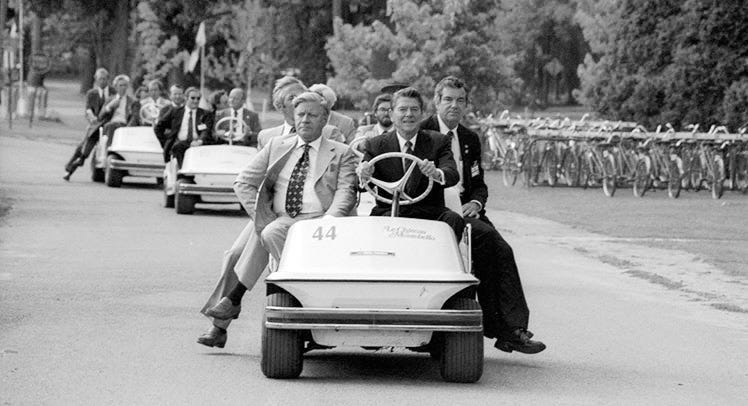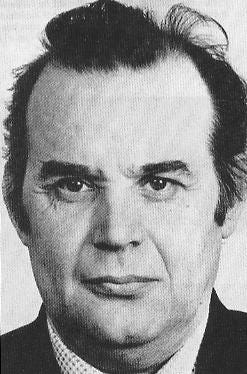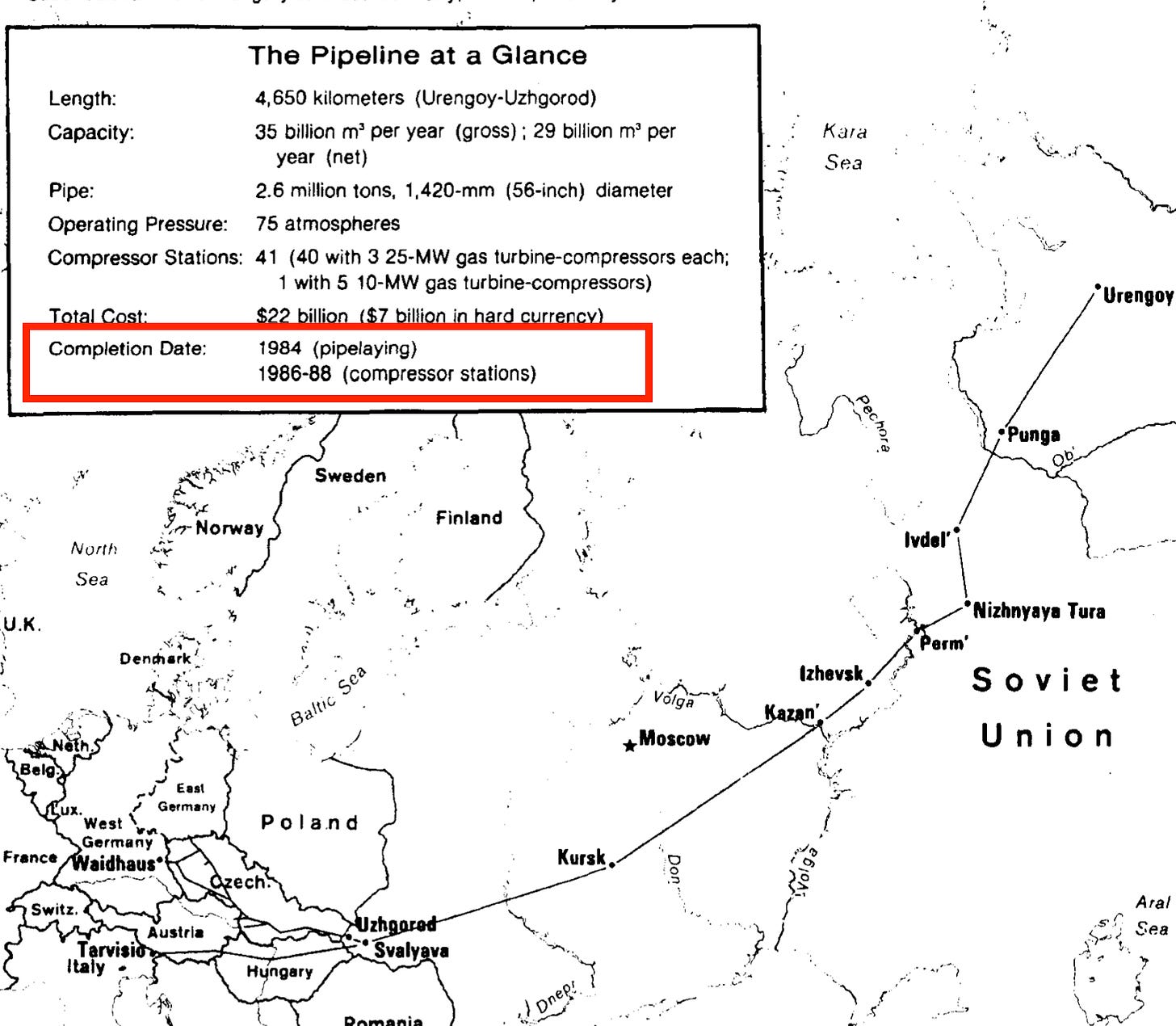The true but untrue tale of spies, murder, economic warfare, and sanctions
Introduction
In 2004, a most unusual story appeared in a spy book written by a person named Thomas Reed (“Reed”), who worked at the US National Security Council. The unusual story was that the CIA blew up a Russian natural gas pipeline in the summer of 1982, with the help of Canada, causing a 3-kiloton blast somewhere in Siberia.
According to Reed, the CIA signed-off on his book, and approved the revelation of this secret pipeline sabotage operation, including that Canada was in on it.
The pipeline in question is the famous Trans-Siberian natural gas pipeline, known as the Urengoy-Pomary pipeline (Трубопровод Уренгой-Помары) in Russia.
It’s a wild story but is it even true? Would two NATO countries, unprovoked, plot and plan to destroy energy infrastructure, blow up a Russian natural gas pipeline, and jeopardize the energy security of Western Europe?
And if the story is untrue, would NATO countries just make up lies about blowing up a Russian natural gas pipeline?
Both seem inconceivable.
To answer these questions, we need historical context, starting with the geopolitical history of that pipeline, and a Russian spy named Vladimir Vetrov.
Part 1: Historical Context
Chapter 1 The Trans-Siberian Pipeline
A win for everyone
In 1953, Russia discovered the West Siberian petroleum basin in Siberia, the largest hydrocarbon basin in the world which covers 3.5 million km2, more than twice the size of Alaska.
By the end of the 1970s, the Soviet Union has been exporting oil, and considered building a pipeline and energy infrastructure to export its natural gas from Siberia to Europe.(1)
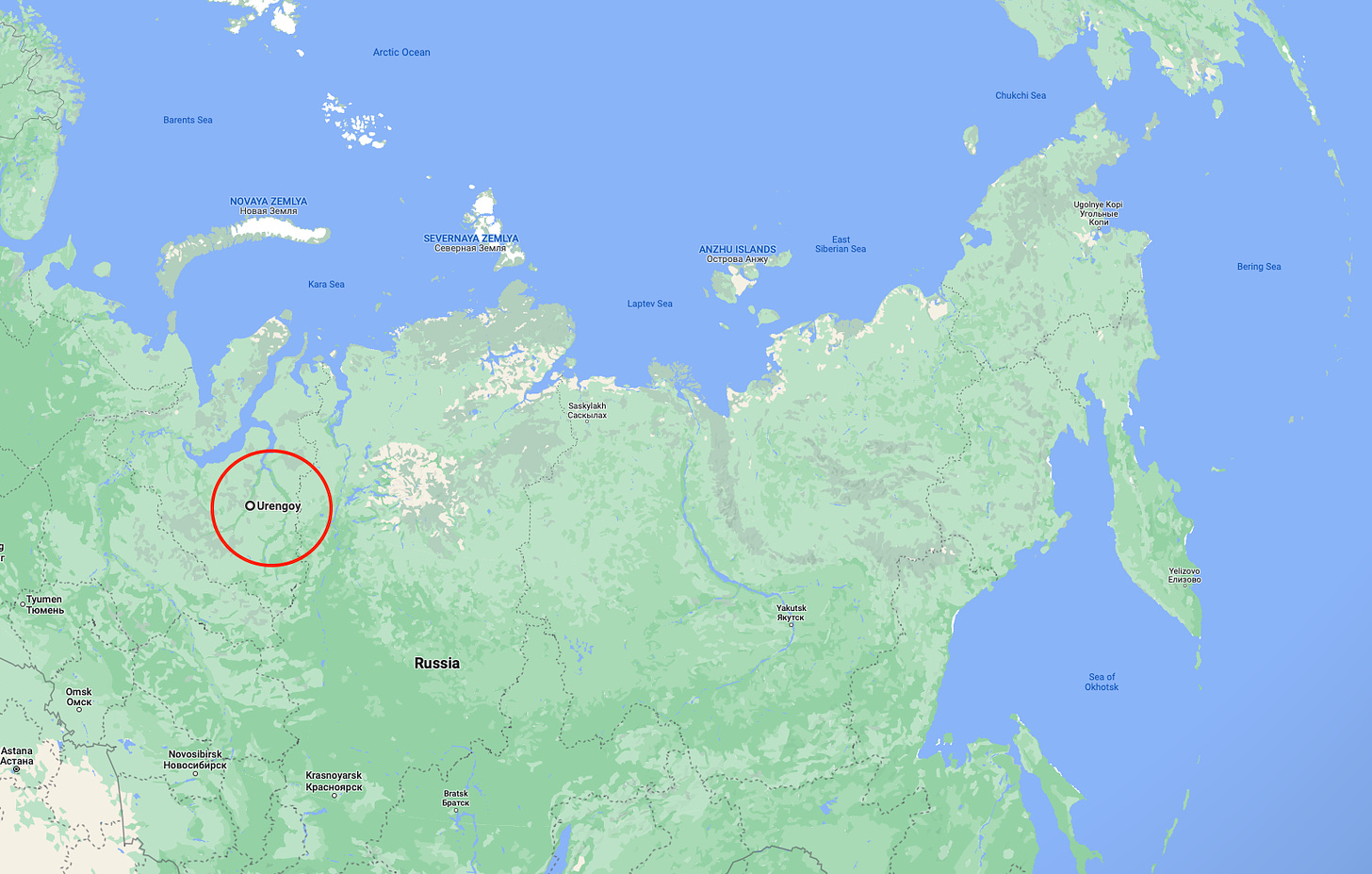
With the discovery of the Western Siberian petroleum basin, the Soviet Government approved the construction a 4,500 kilometer pipeline to transport natural gas from the Urengoy gas fields to Western Europe, equal in length to constructing a pipeline from New York to Los Angeles. At the time, it was the largest engineering and construction project in the world, and when completed, it would be the longest gas pipeline in the world.
The pipeline was a win for everyone – when built, it would subsidize the economy of the Ukraine, and supply inexpensive natural gas to Western Europe, ushering in decades of Western European industrialization, growth, peace, and prosperity.
For the Soviet Union, the Urengoy-Pomary pipeline would generate a 40% increase in the Soviet Union’s gas production, triple its natural gas export capability, and boost its revenues.
You can take a one-minute video tour by helicopter of the 4,500 kilometers during its construction in Siberia, below, filmed in 1983.
To construct the pipeline, the Soviet Union needed financing, vast amounts of equipment, steel, pipes, compressors, and turbines, as well as services.
US economic war against Russia
According to legal and policy research conducted by Case Western University, since as early as 1962, the US Government had a foreign policy of preventing the Soviet Union from selling oil and gas, and to limit its ability to grow economically, the theory being that suppressing the economic development of the Soviet Union, would suppress its technological development, and ergo, its capability to advance militarily and in aerospace.
Back then, there was not much public transparency in real world politics to understand that foreign policy could be based on economic suppression of one country for the economic supremacy of another. Economic warfare may have been charged by one country or another at the time, but was not openly admitted. As we shall see, in the late 1990s and in 2004, the US Government admitted that in the 1980s, it engaged in economic warfare against the Soviet Union primarily to stop it from being able to build pipelines to generate oil and gas revenues to develop its economy.
There was an ideal, naïve though it perhaps was, of free and fair economic competition of every country as a matter of sovereignty, as part and parcel of an open and inclusive international system. In the months to come three key leaders, Margaret Thatcher, Pierre Trudeau and François Mitterrand, would fiercely and publicly battle the US Government to enforce those ideals. And the battleground was Russia’s Trans-Siberian pipeline.
When Jimmy Carter was President of the US, politicians lobbied him unsuccessfully to act against the proposed pipeline, arguing that the pipeline would give the Russians an increasing amount of foreign currency reserves, that they could use to buy technology, develop their economy, and advance military power.(2)
In January 1981, when Ronald Reagan became president, he was more receptive to such lobbying. He wholeheartedly embraced the idea of preventing the economic and social advancement of Russians and economic warfare as the method to make sure that happened. Top of his list was to prevent the natural gas pipeline from being built. That became one of his major foreign policy initiatives.(3)
“Chicken littles” and the secret NATO resolution
To stop the pipeline, the US Government took steps to prevent other countries from entering into contracts with the Soviet Union in a variety of direct and indirect ways, including ordering the International Energy Agency, and the OECD to intervene, and when that was not effective, it instructed NATO to pass a secret resolution to prevent member countries from contracting with the Soviet Union in respect of the pipeline.(4)
The Soviet pipeline team set up shop in Cologne, Germany, and went to work drafting engineering and other specifications for all components of the 4,500 kilometer pipeline. They then set up a system for suppliers and manufacturers from around the world to submit bids to build the pipeline.
A business reporter at the time wrote that there was fierce competition among industry to sell to the Soviet Union. “The race soon involved dozens of companies, competing for contracts, big and small, and the Soviets conducted it all themselves, as one businessman put it, “down to the last bolt””.(5)
In July 1981, the US Pentagon was bitterly at odds with the US State Department over the pipeline – the Pentagon wanted the US Government to do whatever was required to kill Russia’s energy infrastructure project, whereas the State Department advocated for a more cautious approach.(6)
In Cologne, between September 1981, and December 1981, the Soviet negotiators announced the companies that were the winners of bids they had received to build the pipeline.
The CIA provided a secret report to the US Government about the pipeline, and the companies that won bids, which analyzed each contractor and the equipment or service being sold. It identified how much money Russia would earn, the prospect of its foreign currency reserves increasing, and that European supplies (pipes, compressors, and turbines) were going to go to Russia to build the pipeline.
Armed with the details on the identity of the contractors that won bids to build the pipeline, the US Government asked the countries where the contractors were located to interfere and prevent their industries from doing business with the Soviet Union. According to other accounts, they also worked on private company executives for the same purpose. Reagan’s approach to world leaders was not well received, especially in Britain, France and Canada.
On December 21, 1981, Reagan took the pipeline issue to a National Security Council meeting where he famously referred to Western European leaders as “chicken littles,” (an old-fashioned term which means a person lacks bravery), because they wouldn’t go along with the US Government and wanted to sell equipment to Russia, and be able to buy cheap energy from Russia.
Christmas sanctions for American companies
The US Government looked for ways to impose sanctions to stop the pipeline, aware that “it could not impose sanctions on the project without good reason. The only realistic option was to wait for a development that could serve as an excuse to impose sanctions on Moscow.”(7)
It “did not have long to wait … Reagan quickly seized the opportunity [of Poland] to impose sanctions on Moscow … to derail the construction of the Siberian pipeline.”(8)
On Christmas Eve 1981, the US Government announced a first set of sanctions to prohibit the export of US products and technology to the Soviet Union tied to its oil and gas industry. The reason given was Poland which had imposed martial law to quell civil unrest related somehow to the Soviet Union.(9)
Below the surface, the sanctions had nothing to do with Poland, and “were to prevent oil pipelines from entering Western Europe from Russia.”(10)
On December 29, 1981, the US Government then interfered to stop an $80 million contract bid won by Caterpillar Tractor Co., to sell 200 pipelayers for the pipeline, after it had granted the American firm an export licence months earlier.(11)
Illegal summer sanctions for European companies
On June 18, 1982, the US Government imposed a second set of sanctions to stop the Russian pipeline, with retroactive application, by preventing the sale of goods and services to the Soviet Union by foreign subsidiaries of US corporations, and by foreign companies under license from US firms.(12)
These sanctions targeted European companies and were retroactive because the winning bids had already been announced in 1981. To stop the pipeline, it had to tackle the pre-existing contracts.
The retroactive application of the law, vis à vis sanctions, had never been done before (and in fact, retroactive laws are not enforceable under common law) and another first was the application of US law (the sanctions) purportedly over corporations in other countries. “This was an illegal move; the US had no jurisdiction over foreign subsidiaries of American firms.”(13)
Illegal or not, the June sanctions made it clear that the US Government was prepared to use technology as the basis to stunt the economic growth of the Soviet Union by sabotaging its energy industry.(14)
Europe and Canada become hostile to the US
As a result of the second set of US sanctions, European and Canadian businesses became increasingly hostile to US Government efforts to interfere with their contractual relations with the Soviet Union related to the pipeline.(15)
World leaders came out fighting aggressively against what they said were unfair economic practices that did not respect their interests, imposed US foreign policy on them, forced them to choose sides, and infringed their sovereignty.(16)
On the same day that the US Government’s June sanctions took effect, the foreign ministers of the European Economic Community issued a statement that US sanctions were illegal. The British, French, German, and Italian governments told their companies doing business with the Soviet Union, to continue.
The US Government lobbied Western European leaders to impose their own sanctions against Russia on the promise that, if they did so, the US would relax the retroactive application of its sanctions law.(17)

Mitterrand, for one, did not want French companies caught up in the US’ economic warfare against the Soviet Union.(18) On July 22, 1982, France issued a communiqué that it was rejecting US sanctions, which stated that “such measures cause the European companies undue commercial prejudice. Gas pipeline construction contracts concluded by French companies must be honored.”
On August 2, 1982, Britain’s trade minister announced that British firms would also ignore US sanctions, and would help the Soviet Union build the Urengoy-Pomary pipeline. German Chancellor Helmut Schmidt similarly told German firms to ignore US sanctions, and Italy followed suit.(19) Even Canada, on August 13, 1982, announced its objection to US sanctions, directing the government to investigate if US sanctions limited competition and violated the anti-trust provisions of Canada’s Combines Investigation Act.(20)
Undeterred, the US Government began watching, very closely, what large contractors in Europe who won bids, were doing.
In France, Dresser France SA, which had a contract to deliver pipeline compressors, continued with its contractual obligations to the Soviet Union.(21) On August 26, 1982, Dresser France loaded a shipment of compressors on board a ship in France, bound for the Soviet Union. Things were so intense that the French Government ordered the French police to guard the ship. But before the ship had even left the dock, the US Commerce Department issued an order, revoking its export license,(22) stopping it from delivering compressors the Russians had paid for.
Thatcher “deeply angry” and Mitterrand “deeply wounded” by US sanctions over Russia
In another secret report, the CIA reported back to the US Government that Western Europeans were “deeply angry” about US sanctions, especially the retroactive application and extraterritoriality, “which they regard as a serious infringement on their sovereignty.”(23)
Among Western European leaders, the CIA reported that President Mitterrand was the most adamantly opposed to the US economic warfare, believing that the US sanctions were an over-reach of the law.(24)
On September 1, 1982, Prime Minister Margaret Thatcher made a public statement declaring that she was “deeply wounded” by the US policy, promising to defy US sanctions. She stated that British firms selling turbines to the Soviet Union had her full backing, despite the threat of US retaliation. “I feel very strongly that once you have made a deal, you ought to keep to it,” Thatcher said.(25)
On September 7, 1982, Canada stepped up its anti-US sanctions position on the international stage. At an event with Brazil, Canada’s foreign minister called US sanctions an unconscionable, unilateral, extra-territorial application of US law. “Foreign companies operating in the US are expected to abide by US laws and policies. We, who are hosting US companies, demand no less respect for our domestic laws and policies”, the foreign minister said.(26)
Lawsuits and administrative proceedings were launched by several European countries against the US Government, challenging the sanctions.
To avoid public trials over the legality of the US sanctions regime, the US Government eventually repealed the sanctions and the lawsuits were stayed.(27)
It did not mean that the US Government ended its economic warfare against the Soviet Union because, as we shall see, it blew up the pipeline.
Pipeline construction begins
The construction of the pipeline began in mid-1982, and was completed in 18 months, way ahead of the projected five-year construction timeline.
In the Soviet Union, the US sanctions inspired massive Russian patriotism, with a workforce that became motivated to finish the pipeline by 1984, and to design, engineer, and manufacture their own turbines to replace Western ones.(28)
By July 15, 1983, all the pipes had been laid and installed, and the work began on installing 40 compressors that would pump natural gas through the pipeline.(29)
In January 1984, the pipeline was completed, and the first natural gas was transported to Europe.(30)
Chapter 2 False Claims of Forced and Slave Labor Camps
Auschwitz-like allegations bandied around
During the work to prepare for the pipeline, events took a dark political turn.
Two grave human rights violations appeared to emerge related to the Russian pipeline – forced labour camps and enslavement.
In June 1982, the US Government convened a committee hearing to look into the alleged use of forced labor by the Soviet Union to build the pipeline.
Who were the alleged forced labourers? People from Vietnam, who were allegedly sent to the Soviet Union against their will, in vast numbers, and held in forced labor camps.
The committee equated the use of alleged Vietnamese forced laborers being allegedly held in Siberian camps to both Auschwitz and to the American enslavement trade. In the latter, 13 million people were captured in Africa, enslaved, and trafficked to the Americas on an industrial scale.
The committee said it had to look into the issue of forced labour at the pipeline because, according to the committee, during World War II not one country in the world heard the cries of prisoners at extermination and concentration camps set up and operated by the Germans, especially in Poland at Auschwitz.
But now, the committee said it could hear the cries arising from behind the barbed wire in the Siberian forced labor camps filled with incarcerated Vietnamese, who could be heard asking of Americans: “You, our brothers, where are you? What are you doing to hinder this carnage?”
Historically speaking, the people from one country did hear the “cries of prisoners” at the concentration camp at Auschwitz – it was the Russians, who liberated its 7,000 prisoners on January 27, 1945.
According to the report of the hearing, countries and companies that were entering into contracts with the Soviet Union to build the pipeline would be “participating in the largest slave transaction in history.”(31)
The committee made this statement because the alleged use of Vietnamese men locked in camps were allegedly working forcibly, for free, hence in their minds this was equal to the American enslavement trade, only worse because it was allegedly a larger operation – the largest in the world.
Arctic testimony by non-Arctic people
To show that human rights abuses were being meted out against the non-existent Vietnamese laborers in Siberia, a witness from the Soviet Union was called to testify. He said that in temperatures of minus 50 degrees celsius (in which I have lived in Canada), such forced laborers have neither warm coats, nor felt footwear (felt footwear refers to winter boats which are lined with felt), and no warm underwear (warm underwear means, in reference to the Arctic, long underpants and long shirts that are layered under clothing). In this way, through the deprivation of winter clothing in the Arctic region, according to the witness, the Soviet Union was killing 500,000 young men every year.(32)
Although allegedly killing such young men, the Soviet Union was simultaneously allegedly enslaving them, and forcing them to build the pipeline.
The reality is, and I know this from having lived it in the north, a person living in the winter in the north, clothed in the manner described by the witness, would not be capable of working for more than an hour, at most, because of frozen extremities.
I referred to this hearing as representing a dark turn of events because the US Government knew there was no enslavement or forcibly imported labour from Vietnam incarcerated in barbed wire camps. In 1982, CIA spies or Russian informants, were in Russia clandestinely collecting information from various sources, including Vietnamese immigrants in Russia on work visas, regarding labor trends, hiring practices, and employment plans for the pipeline.
The CIA reported, among other things, that there was no forced labor going on, and while the pipeline company would likely hire foreign workers under work permits from many countries, it would be on a limited scale. Contrary to the alleged Auschwitz-like conditions, the CIA’s secret report noted that foreign workers had substantial material and financial benefits working in the Soviet Union because food was cheap, medical care was free, lodging was free, and if not free rent was low, and wages were higher than in the native countries of the foreign workers.(33) This information was the US Government’s own information, known to the committee.
To the Russians: “Die or change”
The fiction of forced labour, enslavement of workers in camps with barbed wire, and terrible work conditions where inadequately clothed men were allegedly forced to perform manual labour in Arctic conditions, was parroted by NGOs and some American newspapers with headlines such as the “pipeline holocaust.”(34)
Such headlines trivialized the horrors of the Holocaust, disrespected its victims, and our soldiers who sacrificed their lives to fight Germany in World War Two. That didn’t seem to matter – the goal was to influence Western companies and Western governments against the Soviet Union for Germans atrocities.
It was hoped that allegations of human rights abuses, even if patently untrue, might stop money and supplies going to the Soviet Union and kill the pipeline. The economic warfare seemed to know no bounds, and while the ideal of free and fair economic competition of every country as a matter of sovereignty existed as words on paper, it didn’t exist so much when it came to Russia.
The committee noted: “without money and goods from the West”, the Russians “will have to change or die.”
Chapter 3 Vladimir Vetrov, the Spy
A KGB spy in Canada, and an RCMP spy in the KGB
Before we explore the story of how the CIA blew up the Urengoy-Pomary pipeline, we have to get to know a Russian man named Vladimir Vetrov because the explosion, if it happened at all, happened because of him.
Vladimir Vetrov (“Vetrov”) (Владимир Ипполитович Ветров), was a KGB agent with a high degree of instability.
In 1965, Vetrov was assigned to his first foreign trip, and was sent to Paris as a spy, posing as an engineer. His job was to recruit mid-level human assets at French companies to be informants. One of his first recruits was at the French company Thomson-CSF, which comes up in our story later. Vetrov tried to recruit another employee at Thomson-CSF named Jacques Prévost, but Prévost informed France’s spy agency, the Direction de la Surveillance du Territoire (“DST”). So now Vetrov was on the DST’s watch list, and DST tried in turn to recruit Vetrov.
Vetrov was recalled to Moscow.
In 1974, the KGB sent Vetrov externally again, this time to Montréal, Canada,(35) to engage in spying activities. He barely lasted a year.
In the first instance, in Montréal, he became involved in reselling stolen jewelry, which came to light when he used his name at a pawn shop to sell the stolen goods. The run-in with law enforcement(36) over the jewelry trafficking drew undue attention to Vetrov. That wasn’t good for a spy; he was supposed to be undercover.
In the second instance, Vetrov attracted the attention of the RCMP.
According to the US National Security Council, at that time, the KGB had an agent in the RCMP named Gilles Borey (meaning the US Government believed that Borey, a Canadian, was a double agent in the RCMP in Canada working for the KGB). Borey learned that the RCMP was targeting Vetrov to recruit him to become an informant.
Borey told the KGB in Moscow about this, and the KGB pulled Vetrov out of Canada.(37)
Vetrov assigned to Department T
In Moscow, Vetrov was formally reprimanded and was not allowed to engage in foreign field work afterwards. He was moved to Department T, a scientific and technical intelligence gathering and analysis unit of the KGB, overseeing the analysis of data on aviation.(38)
In today’s world, Department T is comparable to a military innovation analysis center, which provides analysis on developing technologies, domestic and foreign, and a gap analysis. Many intel agencies in different countries have a Department T, especially for military purposes.
Vetrov was angry at the KGB and the Soviet Union for being banned from doing foreign field work.
He decided he would get back at his country by giving Soviet intelligence to the West. He decided to approach France, because he figured it would be easier because no one gave intelligence to the French.(39)
In February 1981, at Moscow’s Expocentre, Vetrov met with an employee of a French company with whom he was acquainted. Vetrov handed him a note for Prévost, with an invitation to meet to discuss an important issue.(40)
In April 1981, Vetrov met with his old Paris acquaintance, Jacques Prévost in Moscow. Vetrov explained he was prepared to provide Soviet intelligence to the DST. He was taken to meet Patrick Ferran (“Ferran”), a French spy working in Moscow.
It was agreed that Vetrov and Ferran’s wife would meet every Friday at the Cheremushkinsky Market, where Vetrov would make a document drop in her shopping basket.(41)
Vetrov becomes a double agent
Vetrov was now a double agent – working for the KGB, and working against the KGB for the DST.
Over the next 9 months, Vetrov made document drops to Ferran’s wife, providing over 4,000 secret documents to the DST.
In those documents, the DST was able to glean the identity of informants and the identity of KGB agents who worked abroad.(42) Vetrov then provided copies of records with the personal data of KGB officers that he had taken from the KGB safe at the foreign intelligence headquarters in Yasenevo.(43)
The documents from Vetrov revealed the status of the Soviet Union’s technology and industrial progress, and revealed that the Soviet Union was purchasing radars, machines, and semiconductors (44)bfrom Western companies. The documents also contained Soviet Government decisions on military and industrial matters.(45)
A secret shopping list
Allegedly (and I believe this next part of the story to be partially, if not wholly, untrue), Department T created a long shopping list – like a wish list – that identified pieces of equipment and technology that the Soviet Union allegedly desired to buy from the West. This wish list was allegedly provided by Vetrov to the DST, who provided it to the CIA.
The alleged wish list included semiconductors, and, relevant to the Urengoy-Pomary pipeline, turbines.(46)
Part of the reason why this story rings untrue is because of the formal bid process that was set up to procure services, supplies and equipment to build the pipeline.
The bid process was open, and every item needed, down to the bolts, was publicly itemized in tender documents, obviating the need for a secret wish list of equipment for the pipeline. Not only that, there was fierce competition around the world to sell to the Soviet Union at the time, thus there was no need to have a wish list – foreign companies were soliciting the Soviet Union for business, not the other way around.
Part 2: Pipeline Sabotage Plan
Chapter 4 Underground Plan to Destroy the Soviet Economy
Mitterrand offers Reagan summaries of Vetrov’s intel
In July 1981, at an economic conference in Ottawa, Canada, French President Francois Mitterrand informed President Reagan of the documents received from Vetrov, and offered to provide summaries of the intelligence to the CIA.
The French Government and US Government were not on ideal terms at this time, and France was hostile to the US sanctions over the Russian pipeline.
The DST translated the 4,000 Russian documents from Vetrov into French, and then provided only reports summarizing the content to the CIA, starting in August 1981.
The CIA apparently gave Ferran a Minox mini spy camera that was smuggled into the Soviet Union, which Ferran gave to Vetrov to photograph the KGB documents.
It could be that the CIA was expecting the film back from the camera, but DST continued to only provide second hand information in the form of reports of translated summaries of the material from Vetrov.
Vetrov’s plan was to be a paid informant and in writing, he asked the DST to pay him between 30,000 to 40,000 Rubles per year for his services. For reasons which are unknown, it appears that despite his value to them, no agency paid Vetrov.
Retaliation plan to sell Russians defective machinery
In January 1982, Gus Weiss (“Weiss”), a policy advisor to the White House, met with William Casey, the head of the CIA, over the reports from French intelligence of Vetrov’s documents to come up with a retaliation plan against the Soviet Union because it was buying scientific and technological know-how from the West.(47) This was just after the US Government had imposed the first set of sanctions, and blocked the $80 million winning bid from Caterpillar.
William Casey is known because of the Iran-Contra affair, although long before that, he was better known as part of the OSS, which had deep ties to Canada and to Toronto’s Bay Street banking and bond community.
The unrelenting economic war against the Soviet Union was about to go underground.
The retaliation plan would secretly sabotage the entire economy of the Soviet Union(48) by disrupting its ability to supply natural gas, and going after its foreign currency reserves.(49)
This is where the alleged shopping list from Vetrov came into play.
Reed alleged that it was agreed that the CIA would become a kind of a secret personal shopper for the Soviet Union.(50)
Whatever was on Vetrov’s alleged shopping list would be purchased by the CIA from American companies for the Soviet Union, except the items would be modified, flawed, or defective(51), (52) American companies would help to deliberately manufacture defective or inoperable machinery and equipment, and sell such items to industries in the Soviet Union.(53)
According to Reed and Weiss, this industrial sabotage was carried out for quite some time, resulting in the delivery to Russia of large quantities of defective machinery and equipment.
Chapter 5 Canada Gets Involved in Pipeline Sabotage
A KGB agent enters Canada to steal software
The retaliation plan focused on the Urengoy-Pomary pipeline, with a plot to blow it up,(54) revealed for the first time in Reed’s book.(55)
Until Reed’s book, the knowledge that the CIA blew up the Russian natural gas pipeline was a “closely guarded secret”.(56)
This plot, too, was tied to Vetrov’s alleged shopping list.
You see, the alleged shopping list included another item for the Urengoy-Pomary pipeline, namely software for a computerized control system to automate the operation of the pipeline, the pipeline pressure and natural gas flows. That software allegedly was so valuable, it was at the top of the shopping list.(57)
According to the New York Times, an American firm turned down a purchase order from Russia to sell it the system and its software. And when the Soviets allegedly could not buy the software anywhere else in the world, and were unable to write computer code for such requirements themselves, they then sent a KGB agent “to Canada to a company there to steal the software.”(58), (59)
Canada doctors the software to blow up Russian pipeline
However, before the KGB agent snuck in and stole it, the CIA worked with the Canadian company to program a Trojan horse into the software,(60),(61) exactly as Weiss described had been done with American businesses who made defective machinery and equipment, and sold it to Russia – same plan, only in Canada.
For this part of Reed’s story to be true, by necessary implication it means that the following occurred:
- The CIA had visibility to know that a KGB agent in Canada was going to steal a piece of software from the Canadian company;
- The CIA reached out to Canadian intelligence, as required for an operation on Canadian soil, and together, the two intel agencies communicated with the Canadian company and explained the situation;
- The Canadian company agreed to deliberately manufacture a copy of its software that was not only defective but coded it with a Trojan horse to cause an explosion to energy infrastructure;
- Back then, software that was to be transported in this way would have been saved on a floppy disk;
- The Canadian company knew when and how the KGB agent would show up to steal the software, and presumably left the floppy disk out on the counter or some such place so when the KGB agent broke into the premises, he would know what to steal;
- The KGB agent did break in and stole the defective software with the Trojan horse, and brought it back to Siberia;
- Working backwards from the date of the explosion and the time the Trojan horse was in hibernation, the theft in Canada and the software installation had to have happened sometime in January 1982, mere days after Weiss met with the CIA for the first time over the Vetrov information; and
- The computer scientist at the Urungoy-Pomary pipeline took the stolen software and download it to a computer system used to regulate and control natural gas pressure flows.
In sum and substance, combining all the statements Reed made to promote his book, the Canadian company altered the software by adding a few lines of code so that, once installed in Siberia, it worked for four to five months and then, one day, after that length of time, in the summer of 1982, the Trojan horse woke up from a hibernation, and mis-instructed the computers and pumps to increase the pressure in the pipeline so that too much pressure was produced, causing a “massive explosion” of the Siberian natural gas pipeline that was delivering gas to Western Europe.(62), (63), (64)
“The most monumental, non-nuclear explosion ever”
Such a huge explosion was caused to the Urengoy-Pomary pipeline that the US Air Force estimated it to be a 3-kiloton blast.(65)
When the Canadian software caused the Russian natural gas pipeline to explode, Reed alleged that NORAD feared that a missile had been fired from Siberia, or a small nuclear device detonated,(66) but Weiss reassured NORAD it was a US-caused explosion.
The explosion was so massive, it was observed in space and recorded on satellite imagery, Reed said. In fact, it was the “most monumental, non-nuclear explosion and fire ever seen from space.”(67)
Canada helped end the Cold War
The explosion caused by the Canadian software installed on the computer systems of the Urengoy-Pomary pipeline was so bad, so “huge”, that it helped end the Cold War.(68)
In a review of Reed’s book, the Sunday Times summarized the story this way: the US Government’s campaign “to undermine the economy of the Soviet Union” included sabotaging Russia’s Siberian pipeline in 1982. “A vast explosion tore apart the pipeline, caused by flawed software sold to the Russians to wreck the pipeline.”(69)
In this version of events, although the explosion was still vast, and ripped apart the pipeline, the provenance of the software and the perpetrator of the deed is less James Bond – in this version, the sabotaging software was sold to the Soviet Government, and not stolen by a secret KGB agent in Canada.
You may be wondering why the massive explosion was visible from far away in space, caught on satellites, and a handful of people in the US could see, presumably from the satellite pictures, that the pipeline was blown up and ripped apart but yet no one on Earth or in Russia, not even in Siberia, witnessed it. That is explained by an American newspaper in 2004 – it is because it happened up yonder in the Siberian wilderness,(70) where presumably no one lives.
When the Urengoy-Pomary pipeline exploded, the Soviet Union was allegedly “red-faced” but could not complain;(71) they could not complain, we are told, because the software had been stolen from Canada, and complaining about the sabotage of its energy infrastructure caused by stolen software would be an admission of the KGB theft in Canada.
Chapter 6 Vladimir Vetrov, the Murderer
The spy murders a stranger
Back in Moscow, Vetrov had been having an extramarital affair with a KGB translator.
Sometime in March 1982, on a date-night, Vetrov tried to murder his girlfriend with a screwdriver in a parking lot. A random stranger, who heard her screams, intervened to stop the murder, and Vetrov then attacked him with the screwdriver, stabbed him in the heart and killed him.
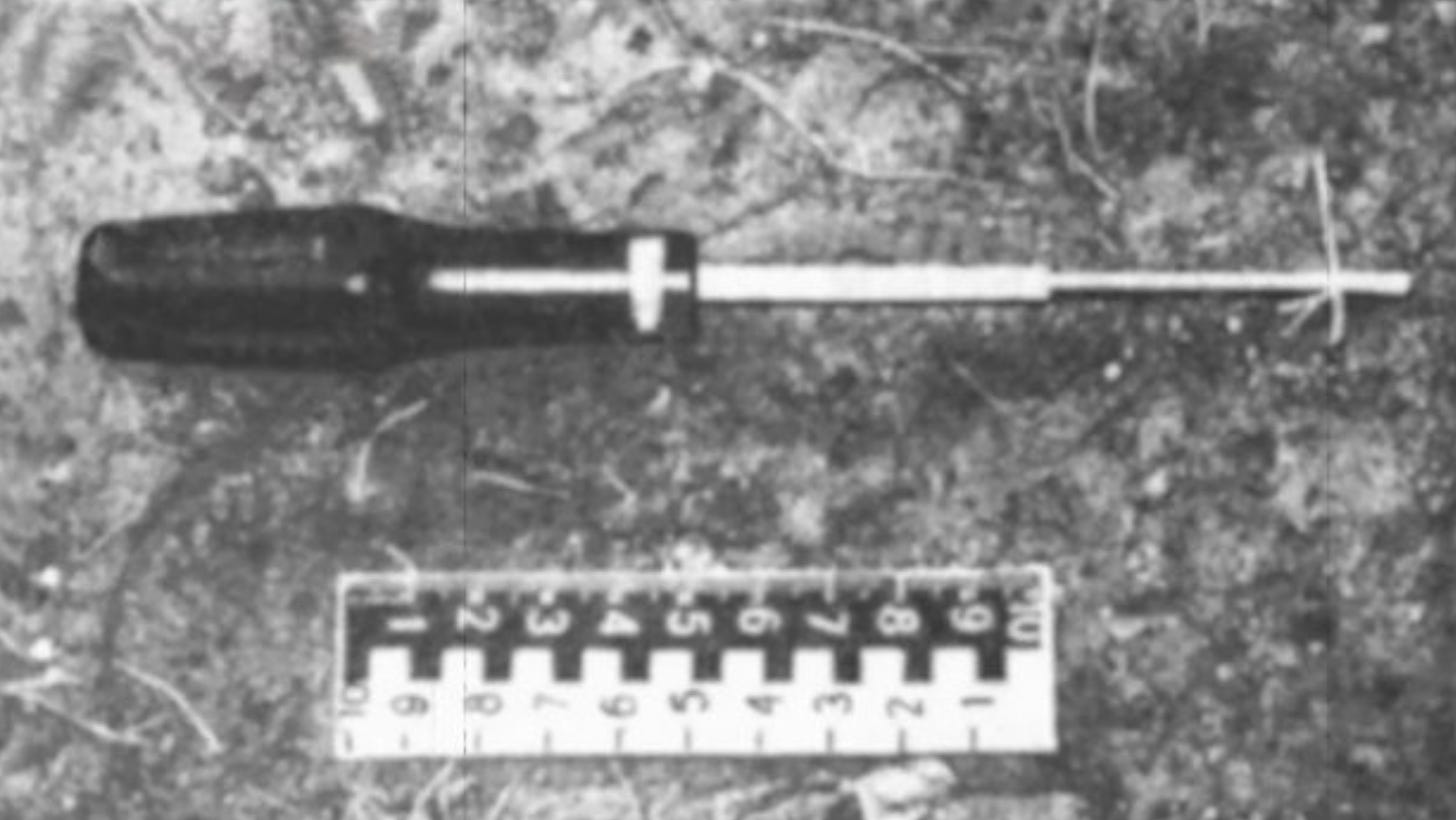
Vetrov was arrested and held in remand until his trial. It meant that the flow of KGB intelligence to France suddenly stopped, and French intelligence never heard from Vetrov again.
Vetrov was tried in November 1982, and convicted of murder.
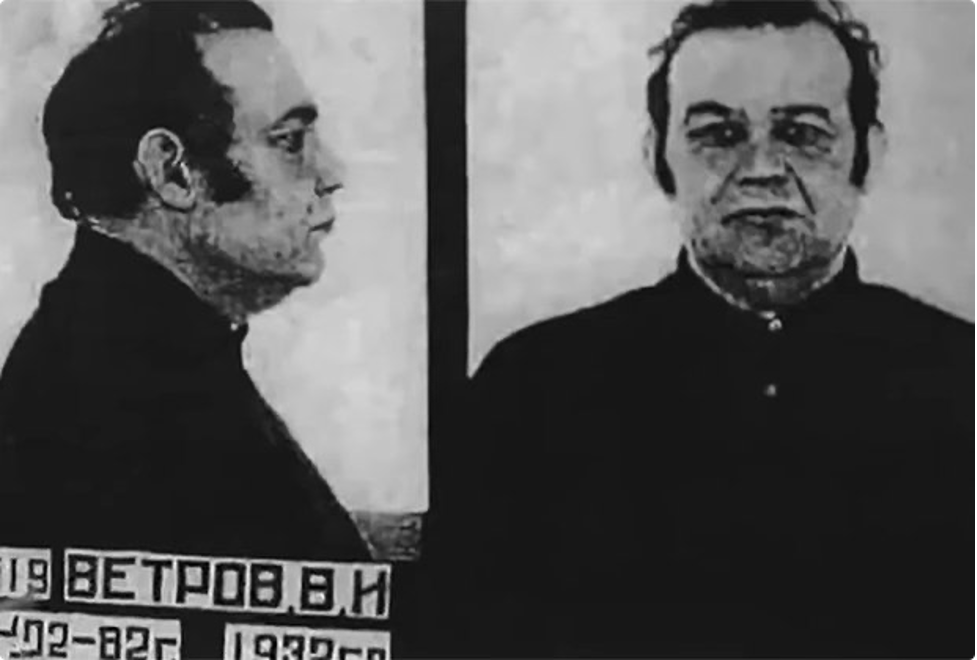
How Vetrov was revealed to be a double agent to Russia is unknown.
Soviets discover Vetrov was a double agent
In prison, he told prisoners that he had engaged in espionage, but his statements were not believed. Eventually, Vetrov’s apartment was searched and authorities found the Minox mini spy camera, consistent with his story of having engaged in espionage against the Soviet Union, because those cameras were not available in the Soviet Union.(72)
He also wrote a letter from prison to his wife, asking her to contact the DST to look after her financially for his services to the DST, which was read by prison authorities.
According to a different, probably more plausible, version of the story, in 1983, the Soviet ambassador in Paris was summoned to a meeting and shown a document by the French that had clearly been leaked from Department T, which demonstrated that there had been a foreign breach of Department T. From that, the Russians deduced that Vetrov had given intelligence to the French. They were able to make that deduction rapidly because, for French intelligence to have revealed that it possessed that document, meant that the source was no longer providing intelligence to the West (they were burning Vetrov), and because they exposed that fact, it was easy to determine who had access, and who was now gone from Department T – it was Vetrov, who was in prison for murder.
In August 1983, Vetrov was charged with treason. He confessed to handing over 4,000 documents that were classified as top secret to the French, including resolutions from KGB chairman Yuri Andropov, and notes from Leonid Brezhnev.(73)
He was found guilty of treason, and in 1985, he was shot to death.
Chapter 7 James Bond-Style Fiction
Fact or fiction?
You have probably guessed that Reed’s story that the CIA, with the help of Canada, blew up the natural gas pipeline cannot possibly be true.
We know that because, when the alleged “massive explosion” of the pipeline occurred in June 1982, the pipeline was not even built yet, and natural gas could not possibly have been flowing through it, for it to have blown up in the dramatic fire-infused James Bond way Reed described. It was not until early 1984, when the pipeline was built, that natural gas was pumped through the pipeline for the first time.
The date the Urengoy-Pomary pipeline opened is a known historical fact, and such date is 1984. Even the CIA, in a report dated August 1982, two months after the alleged explosion, wrote that the date for only the pipelaying completion was 1984.(74)
The imposition of sanctions also does not align with June 1982 alleged explosion that Reed claimed happened. When that pipeline was sabotaged was the exact time when the US Government was imposing its controversial second set of sanctions to stop the pipeline from being built. It was seeking to impose those sanctions because the pipeline was not yet built, to stop it being built. If Reed’s story is true, it means the US Government was imposing sanctions on a pipeline it had just blown up.
There is also the political issue of Canada’s alleged involvement as the main saboteur.
At the time, Prime Minister Pierre Trudeau was adamantly opposed to US sanctions, so much so that when the alleged KGB agent was stealing software in Canada as a controlled operation, Canada was looking at suing the US Government for anti-trust behavior in respect of the US sanctions. It seems inconsistent that Prime Minister Trudeau would agree to look the other way knowing that a KGB agent was entering Canada to steal software for the very pipeline the government was going to sue over to be able to help construct.
Prime Minister Trudeau was “deeply disturbed by the animosity between Washington and Moscow,” and in particular what he called the “overly hostile rhetoric of Ronald Reagan towards Moscow.” Trudeau devised his well-known peace plan at the time to be a catalyst for cooperation and peaceful relations over this very issue. It appears inconsistent with peaceful relations and with that peace plan for Canada to have sabotaged and blown up a Russian natural gas pipeline.
Thomson-CSF enters the picture again
Another problem with Reed’s story is the computerized control system with the alleged defective Canadian software – it had not even been delivered to Russia in the summer of 1982.
According to a 1982 secret report by the CIA, France’s Thomson-CSF was the company that won the bid to sell the Soviet Union the computerized control system and software to control gas flows within the pipeline,(75) not a company from Canada. If the bid was won, why would a KGB agent need to sneak into Canada and steal the software?
According to Thomson-CSF itself, the project to install the computerized control system and the software to control gas flows took almost a decade to complete, and was finished only in 1991.(76)
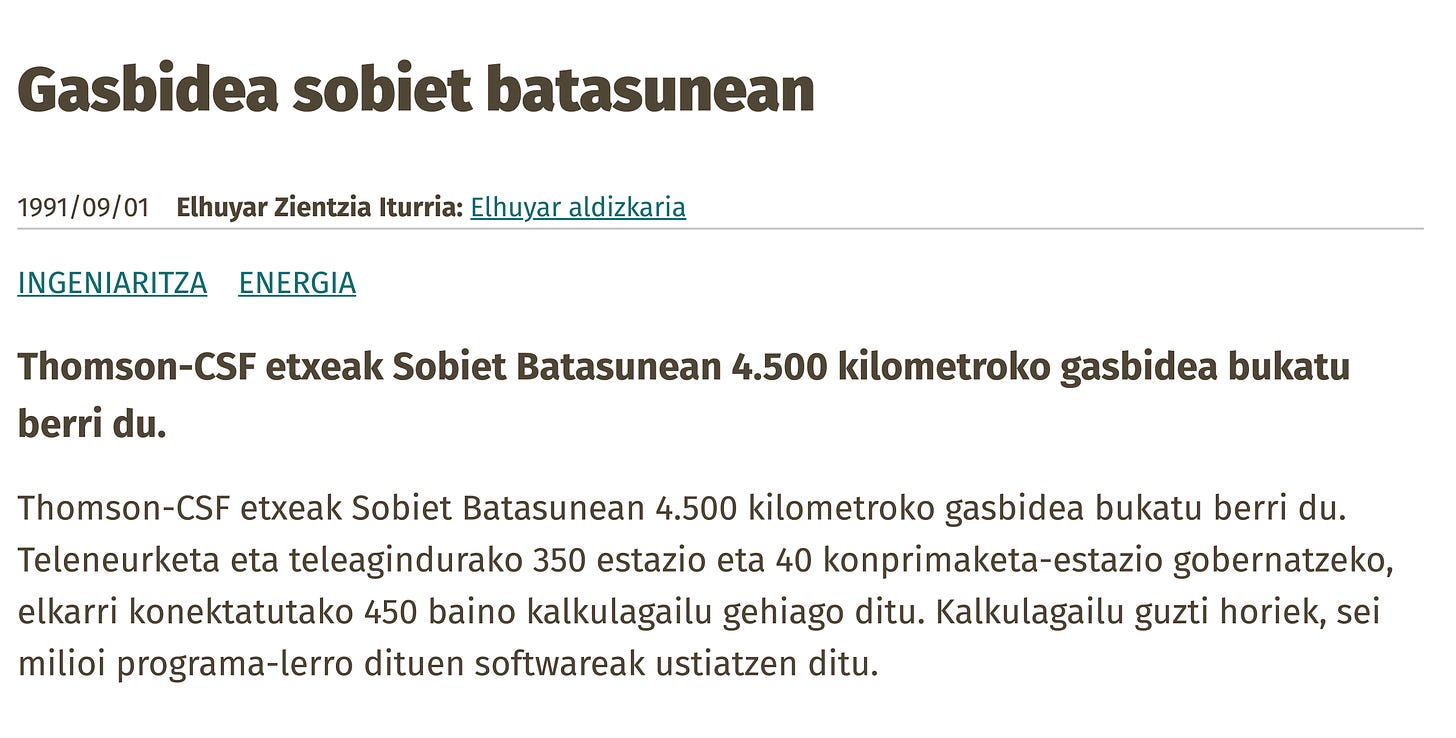
It is odd, though, that the computer contract went to Thomson-CSF, the company that Vetrov had connections to, who had introduced him to the DST when he wanted to become a double agent. The Soviet Union did not know this when the contract was awarded to Thomson-CSF, but the CIA did, and so did the DST. And so did Thomson-CSF. Remember that an American firm allegedly pulled out of the bid to supply the computer system and Thomson-CSF got the bid – was that because there was already an infiltration into the KGB through Prévost at Thomson-CSF and Vetrov, and the goal was to keep that door open?
It’s possible – because of the scam perpetrated on Areva S.A. by the Canadian company Uramin Inc., and the resulting media and French government investigations into the Canadians behind that scam in France and Africa, the world learned how bid processes were used in China for foreign espionage. Its curious that Thomson-CSF is a common denominator – it was Vetrov’s DST contact when he was a double agent; it was the contractor for the pipeline; and it was in Vetrov’s alleged shopping list.
A little bit of high school science
In 2017, a Russian gas pipeline engineer looked into the allegation that the Urengoy-Pomary pipeline was blown up by the US Government.
According to him, gas pipelines are built to withstand pressure surges, and have pressure relief valves along the entire length of the pipeline, which operate independently of central control systems.(77)
If the pipeline existed in the summer of 1982, and had experienced a pressure surge, pressure relief values would have released the pressure, preventing an explosion.
Moreover, he explained that it is not possible to have a natural gas pipeline explosion of 3-kilotons because volumetric explosions, including volumetric detonating weapons, are limited in power, especially in open space, meaning that such an explosion could not, as a matter of pure physics, have been 3-kilotons, or have been visible from space,(78) as Reed alleged.
According to Reed, the 3-kiloton gas explosion visible from space destroyed the pipeline, but caused no other damage.
Let’s compare that to history.
The largest non-nuclear explosion in history was in 1917, in Halifax, Canada, and it was also a 3-kiloton blast. The explosion in Halifax sent out powerful shockwaves that broke windows 50 miles away. An estimated 1,500 people were killed from the explosion and shockwaves, and 12,000 buildings within a 16-mile radius, were damaged.
Although Reed’s pipeline explosion was also a 3-kiloton blast, no house or office windows were broken, no one was killed, no shockwaves were felt, no buildings were damaged.
Another contrast – the 2015 explosion in Tianjin, China, was 0.75-kilotons.(79)
It left a crater in the Earth, whereas the 3-kiloton explosion of the Russian natural gas pipeline in Reed’s story left no mark. The video below of a 0.75-kiloton blast gives an indication of what a blast of over three times that might sound and look like.
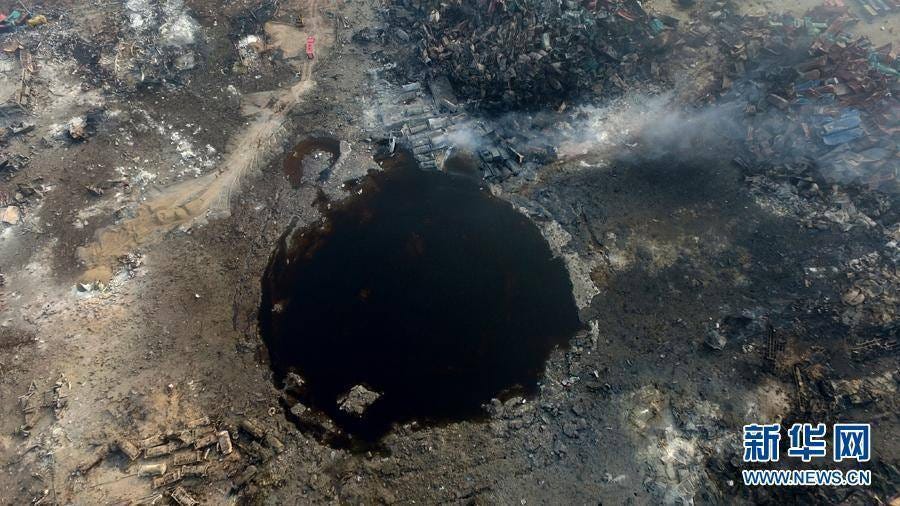
Fateh Vygasov, who worked at the gas pipeline construction headquarters in Western Siberia also assessed the story as impossible.
Among the reasons he cited were the pipeline’s compressor station shut-off valves, which would have been mechanically triggered during pressure surges. He stated that if an explosion occurred, it would only have demolished the ground strapping of a well, perhaps causing a fire, that would have burned out after a few hours.(80)
Chapter 8 No Answers
The true but untrue story hurts Canada
Reed said his book, and the details of how the CIA, with Canada’s help, blew up a Russian natural gas pipeline, was thoroughly vetted by the CIA, and approved for publication.(81)
That is true.
Former intelligence officers are required to obtain permission to publish books or articles about their former intelligence activities and to disclose state secrets.
Vis à vis Canada, it also means that Canadian intelligence had to have signed off on Reed’s book too because the blame for the actual sabotage, according to Reed, lies at the feet of Canada, whose software industry, he alleged, was part of the conspiracy to blow up the energy infrastructure of another country, with which it was not at war.
There are lots of mysteries and intrigue in the story of the blowing up of the Urengoy-Pomary pipeline but the most mysterious part of the whole episode is why would this fake story be created and published?
It’s hard to say; there are no answers.
Even though Reed’s story is not a true story, the whole world has believed it since 2004.
The story, although untrue, is endlessly harmful.
We are left with a terrible permanent hit to the reputations of Canada and the United States as countries whose manufacturers create defective and inoperable machinery and equipment and sell to foreign companies, and as countries who willingly break international law and destroy pipelines that supply energy to millions of people in the world, and to businesses to keep industries growing, and economies flourishing.
The next time there is a sabotage or attack on energy critical infrastructure, or a natural gas pipeline, the world may point a finger at those who said they did it before, and even bragged about it in books and newspapers.
James Bond: “Great Soviet achievement”
The Urengoy-Pomary pipeline appeared in the 1987 James Bond spy film “The Living Daylights”, which showed a KGB agent defecting to the West inside the pipeline, miraculously surviving several hours under atmospheric pressures that can reach 1,400 psi.
James Bond calls it “a great Soviet achievement.”
Indeed it was – but it was more than that – it brought together the best of American, French, British, Italian, German and Soviet design, engineering, know-how and technology to build the world’s longest pipeline, which brought a long period of industrialization, peace and prosperity to Europe and Russia, alike.
And it stands as an example of the employment of the international machinery for the promotion of the economic and social advancement of all peoples, as Roosevelt and Stalin envisaged so many years ago with the United Nations Charter.
Timeline
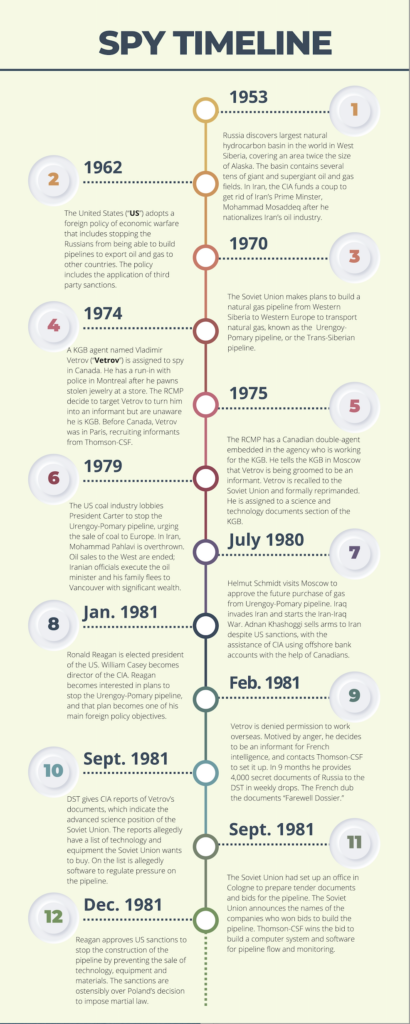
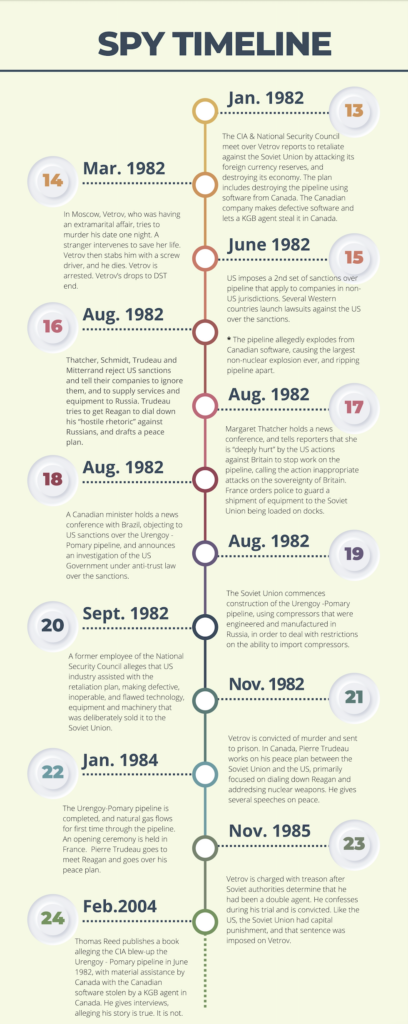
Footnotes
1 April 2016, “Pipeline Politics between Europe and Russia: A Historical Review from the Cold War to the Post-Cold War.” The Korean Journal of International Studies.
2 June 18, 1982, “Human Rights Consequences of the Proposed Trans-Siberian Natural Gas Pipeline.” Hearing before the Subcommittee on International Finance and Monetary Policy of the Committee on Banking, Housing, and Urban Affairs, United States Senate.
3 August 24, 1984, “Reagan: the Ayes Have It.” National Review.
4 “Pipeline Politics”, supra.
5 1985, “Soviet Negotiating Strategy, The East-West Gas Pipeline Deal 1980 -1984.” The Rand Corporation.
6 2023, “The Polish Crisis of 1981-82.” Margaret Thatcher Foundation Website.
7 2022, Agathe Demarais, “Backfire: How Sanctions Reshape the World Against US Interests.” Columbia University Press.
8 Ibid.
9 1983, “Taking Peacetime Trade Sanctions to the Limit: The Soviet Pipeline Embargo.” Case Western Reserve Journal of International Law.
10 2016, “The Reagan Pipeline Sanctions: Implications for US Domestic Policy and the Future of International Law.” Journal of International Affairs.
11 December 29, 1981, “Caterpillar Sale Blocked.” United Press International.
12 “Taking Peacetime”, supra.
13 Desmarais, supra.
14 “Pipeline Politics”, supra.
15 January 27, 1984, “Business, Labour and the Anti-Communist Struggle.” National Review.
16 “Talking Peacetime”, supra.
17 Desmarais, supra.
18 Ibid.
19 August 2, 1981, “World News & Summary.” United Press International.
20 August 13, 1982, “External Affairs Minister will Host a Two Day Gathering.” United Press International.
21 “Talking Peacetime”, supra.
22 Ibid.
23 August 1982, “Outlook for the Siberian Pipeline”. CIA.
24 August 1982, “Outlook for the Siberian to Western Europe Natural Gas Pipeline”. CIA.
25 September 1, 1982, “Prime Minister Thatcher Says She was Deeply Wounded”. United Press International.
26 September 7, 1982, “External Affairs Minister Called for an Urgent Reversal”. United Press International.
27 “Talking Peacetime”, supra.
28 August 2, 1982, “Europe: Imbroglio over a Pipeline.” Time Magazine.
29 August 27, 1983, “Tass says Gas Pumped Through Siberia Pipeline”. United Press International.
30 December 20, 2022, “Газопровод Уренгой – Помары – Ужгород”. RIA Novosti.
31 “Human Rights Consequences”, supra.
32 Ibid.
33 June 1981, “Foreign Labor in the USSR.” Director of Intelligence, CIA.
34 August 17, 1982, “Calling it a Pipeline Holocaust, a Republican Senator Introduced Legislation.” United Press International.
35 2023, “Ветров, Владимир Ипполитович”. Wikipedia.
36 July 2, 2023, “Самый важный агент холодной войны”. Как офицер КГБ стал французским шпионом и сдал сотни советских разведчиков в Европе.
37 Ibid.
38 October 28, 2016, КГБ И Агенты Иностранных Разведок.
39 “Самый важный агент холодной войны”, supra.
40 Ibid.
41 Ibid.
42 April 23, 2004, “Полковник Ветров, Он Же Агент Farewell”. FSB Website.
43 “Самый важный агент холодной войны”, supra.
44 March 7, 2004, “Взрыв недоверия. Досье Farewell содержит ложь?”
45 “Самый важный агент холодной войны”, supra.
46 1996, “Duping the Soviets: Farewell Dossier.”
47 Ibid.
48 February 27, 2004, “Reagan Approved Plan to Sabotage Soviets”. Washington Post.
49 Ibid.
50 February 2, 2004, “The Farewell Dossier”. The New York Times.
51 “Reagan Approved Plan”, supra.
52 “Duping”, supra.
53 “Reagan Approved Plan”, supra.
54 Ibid.
55 Ibid.
56 Ibid.
57 “The Farewell Dossier”, supra.
58 Ibid.
59 “Взрыв недоверия”, supra.
60 “The Farewell Dossier”, supra.
61 March 28, 2004, “Soviets Burned by CIA Hackers?” Wired.
62 Ibid.
63 “Reagan Approved Plan”, supra.
64 “Взрыв недоверия”, supra.
65 “Soviets Burned”, supra.
66 “Reagan Approved Plan”, supra.
67 Ibid.
68 “The Farewell Dossier”, supra.
69 February 29, 2004, “Reagan’s CIA Blew up Pipeline Build by West”. Sunday Times.
70 “The Farewell Dossier”, supra.
71 Ibid.
72 КГБ И Агенты Иностранных Разведок, supra.
73 Ibid.
74 “Outlook for the Siberian to Western Europe Natural Gas Pipeline”, supra.
75 September 21, 1982, “The Soviet Gas Pipeline in Perspective”. CIA.
76 September 1, 1991, “Gasbedea Sobiet Batasunean”. Zienzia.
77 “Soviets Burned”, supra.
78 Ibid.
79 October 5, 2020, “Beirut Blast was Historically Powerful”. BBC.
80 “Взрыв недоверия”, supra.
81 2004, “Countdown to Zero Day: Stuxnet and the Launch of the World’s First Digital Weapon.” Crown.
